
New native freshwater fish found in Suriyakanda stream
A Sri Lankan researcher has revealed a new species of loach, a freshwater fish, found in a stream in Suriyakanda.
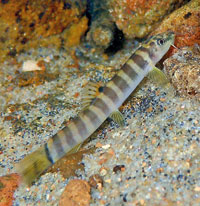
Banded Mountain loach
Loaches are bottom-dwelling freshwater fish that live in natural streams as well as rivers, the researcher notes.
During a fish survey in Suriyakanda two years back, researcher Hiranya Sudasinghe found a fish that looked different from other known loaches. He has proved it is a fish species new to science. The findings were published this week in the acclaimed scientific journal ZooTaxa, officially recognising the fish as a new species endemic to Sri Lanka.
It has been classified as Schistura madhavai in honor of Prof Madhava Meegaskumbura, a senior researcher who has discovered a number of new species. Mr. Sudasinghe who graduated from the University of Peradeniya also recalls Prof Meegaskumbura’s guidance. Mr. Sudasinghe’s previous research led to recognising two new catfish species endemic to Sri Lanka.
The new fish was recorded from a small stream about two metres wide in Suriyakanda. The stream flows through a tea plantation. Suriyakanda is about 1,000 metres above sea level, so the new fish has been tagged as a hill-stream loach. In his research papers, Mr. Sudasinghe says, loaches have small barbels which act as sensory organs that helps them to find food on murky bottoms of freshwater streams. Most loaches have either three pairs or four pairs of barbels and the new member has three pairs of barbels, the researchers explains.
The researcher says little is known about the biology of these species in Sri Lanka though there are four other loaches commonly called as ‘Ahirawa’ in Sinhala. Revealing an interesting fact, Mr. Sudasinghe says in his research paper that the native freshwater fish recorded from the highest elevation in Sri Lanka could be a loach. It is the endemic Sri Lanka banded mountain loach (Schistura notostigma) found above 1,200 metres in hill country.
He says in his paper that the spiny loach (Lepidocephalichthys thermalis) is the most common of all the loaches in Sri Lanka found in a variety of habitats including streams, tanks, rivers and ponds in both dry and wet zones. It has a high tolerance towards environmental and physical parameters and sometimes found in harsh conditions as well, he says in the published research.

Common loach
Even its name “thermalis”, is derived because it was first discovered and described from the hot springs in Kinniya, Trincomalee, Mr. Sudasinghe says in the paper. However, it is not endemic and found in India as well.
Tiger loach (Paracanthocobitis urophthalma) is another endemic fish in this group found in streams and rivers in the lowland wet zone. The bands in the body of Tiger loach is similar to that of a tiger, the researcher says in the paper.
The endemic fish known as Sri Lanka Jonklaas’s loach (Lepidocephalichthys jonklaasi) is found only in well-shaded small streams in lowland rain forests and is known only from few scattered localities making it critically endangered, just few steps from extinction, Mr. Sudasinghe’s research paper says.
Mr. Sudasinghe says the new loach, too, had been found only from one stream in Suriyakanda and not anywhere else. This is a risk to the fish’s survival.
However, there is possibility that the new loach be found in other streams in the area. With the new discovery, the number of Sri Lanka’s freshwater fish increased to 88 and 55 of them are endemic to the country.
Source – 27/08/2017, The Sunday Times, See more at – http://www.sundaytimes.lk/170827/news/new-native-freshwater-fish-found-in-suriyakanda-stream-256501.html
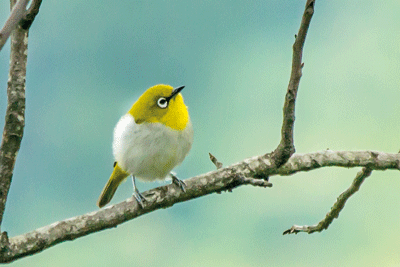
White-eyes create quite a flutter
Research on two species of a small and delicate bird found in Sri Lanka have opened up questions with far reaching implications on genes and evolution not just in the world of fauna but also the human species. Kumudini Hettiarachchi reports
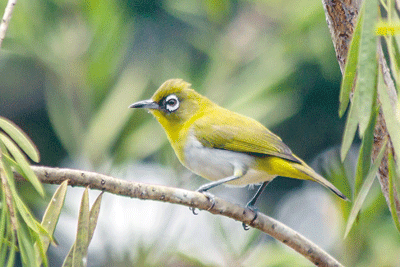
The highland Ceylon White-eye
A surprisingly exciting ‘revelation’ surrounds a common bird, most often heard rather than seen, rocketing Sri Lanka to a ‘unique’ branch with regard to genes and evolution.
Small and delicate is the bird with a distinctive white ring around its eye, aptly named White-eyes of the genus Zosterops who gave Zoologist Nelum Wickramasinghe and her supervisor, evolutionary biologist and geneticist Dr. Sampath Seneviratne, an “unexpected” but “pleasant” surprise when they attempted to establish whether the two species in Sri Lanka were sisters.
The endemic highland Ceylon White-eye (Zosterops ceylonensis) flying in the mountains is a distinct species, with no sisterly links (relationship), while Sri Lanka’s lowland kind, the Oriental White-eye (Z. palpebrosus), is on the same branch as India’s Oriental White-eye, inhabiting both the highlands of the Western Ghats (Z. palpebrosus nilgiriensis) and the lowlands.
The bigger surprise that caught them unaware is – the Ceylon White-eye in the central hills is a ‘root species’ and has come from the ancestor of all White-eyes of the world. These findings have now become the basis of questions being asked about the origins of the White-eyes, whether they evolved in Southeast Asia as thought before or in South Asia on our very own soil.
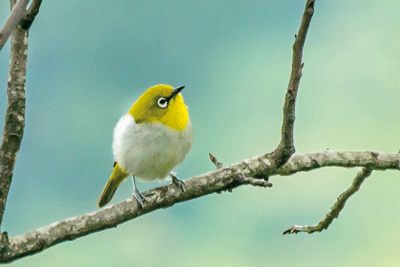
The lowland Oriental White-eye. (Pix by Moditha Kodikara-arachchi)
This study also determines without doubt that the Ceylon White-eye is the oldest in the world as at present, as we know of. It is spotted flitting around at the Nuwara Eliya golf course, the Victoria Park or tea estates of the central highlands. “It is difficult not to see it,” says Dr. Seneviratne.
These passerine birds (songbirds or perching birds) are canopy-dwelling, with their upper bodies covered in olive-green feathers, yellow throats and yellow or grayish-white bellies. They hover around flowers, piercing them, tasting the sweet nectar and also feeding on buds, petals and the hapless tiny insects within them.
Sri Lanka’s lowland White-eye, commonly found here as well as in the South Asian region, is more often than not heard through its cicada-like call rather than seen, says Dr. Seneviratne.
During the study, the team debated and discussed whether their findings could be due to an odd data point? Did the Ceylon White-eye which may have flown in from Southeast Asia become isolated in the central hills while all the others of the same species became extinct or are yet to be discovered in some hidden pockets elsewhere?
Also how far apart are the Ceylon White-eye and the lowland White-eye? The time-axis was an eye-opener. The highland Ceylon White-eye appeared 1.8 million years ago and the lowland White-eye 0.5 million years ago. So the Ceylon White-eye is “very old”, more than a million years, while the lowland White-eye is “very young”.
Another interesting trace was that the lowland White-eyes of Sri Lanka are close relatives of those in Senegal in Africa which is a pointer that they would have been colonized by those from Sri Lanka and southern India. The highland Ceylon White-eye, however, is related to the Southeast Asian White-eyes.
This reveals that the two species of White-eyes in strategically-placed Sri Lanka have links with those in two different directions — Africa and Southeast Asia respectively.
In the study, birds along two transects in Sri Lanka – Colombo to Pidurutalagala in the Wet Zone and Namunukula to Bundala in the Dry Zone – and one transect in India – Kerala coast to Palani hills – had been studied.
Both Pidurutalagala at 2,400 metres above sea level and Palani hills at 2,500 metres are similar elevation-wise but the gradient of the former is 100km and the latter much smaller at 700km.
What the researchers set out to find was:
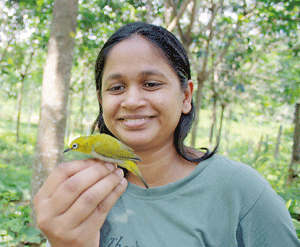
Researcher Nelum Wickramasinghe
Are the two species of White-eyes in Sri Lanka sisters or totally different? Is one or the other a sub-species of the Indian White-eye?
Did the gradient of the two mountains, Pidurutalagala which is steeper and Palani which is not so steep, have an impact on speciation?
Was speciation impacted by the smaller numbers of these birds in Sri Lanka?
The first year of study revolved around morphology (colour, shape, size and plumage); vocalization (calls and singing); and genetics through mitochondrial and nucleus DNA testing bringing about the unexpected results.
Funded by the National Research Council, the project was an “ambitious” one, and Dr. Seneviratne pays tribute to his ‘golaya’ Nelum as one of few who could have handled it.
These important findings have been published in the open-access peer-reviewed PLOS (Public Library of Science) 1 on August 9, 2017. Considered the largest journal by its number of publications, it is of high-volume as well as of high-impact and is used as a teaching tool.
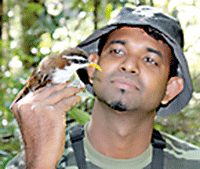
Dr. Sampath Seneviratne
White-eyes, from the Old World itself, are spread across the tropical belt and were earlier believed to have had Southeast Asia as their centre of divergence, from where they took wing to South Asia including Sri Lanka and onto Africa.
This is one notion that has been dispelled with confirmation that the root species is still stuck in the hills of Sri Lanka.
“We began studying one thing but ended by stumbling onto a much bigger find which not only throws light on these birds and other animals’ evolution but also on our own (human) evolution,” says Dr. Seneviratne of the Colombo University’s Avian Evolution Node under the Faculty of Science, Department of Zoology and Environment Sciences.
The study team was “really interested” and picked the White-eyes because they are a “special” group in studies on evolution as they have the highest rate of evolution among the current vertebrates across the world. While Ms. Wickramasinghe is also from the Avian Evolution Node and India’s National Centre for Biological Sciences, Tata Institute of Fundamental Research, Bangalore, the others involved are V.V. Robin and Uma Ramakrishnan from the National Centre for Biological Sciences and Sushma Reddy from America’s Biology Department, Loyola University Chicago, Illinois.
Pointing out that White-eyes are dubbed the ‘Great Speciators’, Dr Seneviratne explains that they are the fastest evolving group in current times. To the uninitiated, he introduces ‘speciation’ as a process in evolution where new species are formed from an ancestor. The main facet of evolution or origins of any animals is speciation.
While studying speciation may be an academic exercise, it is the “very root” of all biodiversity, he says. For, biodiversity comes in the wake of many speciations and as such speciation is central to the very existence of both fauna (animals) and flora (plants).
Dealing with why the White-eyes are undergoing rapid speciation, Dr. Seneviratne refers to the “special network of genes” that they have – a mix of hydrophilic (water-loving) and hydrophobic (water-hating) genes.
“Wherever they may be when in the hydrophilic phase they freely roam all over, across seas and large water bodies to colonize the lands beyond. However, when in the hydrophobic phase, they will not stir even over a river,” he says, adding that this causes both isolation and speciation. This is also a major factor for some of them to live in isolation, stuck in tight pockets but all the while undergoing a rapid increase in speciation.
Citing the old view, Dr. Seneviratne says that the thinking is that the ancestor of the White-eyes was in Southeast Asia and in the hydrophilic phase, flew over the Pacific, colonizing along the way the hundreds of islands dotting the area. Thereafter, the White-eyes on those islands evolved into their own different species and in the hydrophobic phase dared not cross even a small river.
Humans have also followed a similar pattern of hydrophilia and hydrophobia, it is learnt, with Polynesians, in the south, travelling from New Zealand to countries as far Peru and Chile in South America, colonizing the islands along the way. The Vikings from Scandinavia did the same in the world’s north. While this would be the hydrophilic phase, the hydrophobic phase would see them establish in those countries, becoming set in the way they live within their very own cultures and speaking their very own languages.
“Humans have been great voyagers, sailing across the high seas but later becoming more sedentary, growing in population to 700 billion with much diversity,” says Dr. Seneviratne, adding that hominoids have passed that rapid phase of divergence over 5 million years. This is while the White-eye has evolved over 2 million years.
Source – 27/08/2017, The Sunday Times, See more at – http://www.sundaytimes.lk/170827/plus/white-eyes-create-quite-a-flutter-256157.html
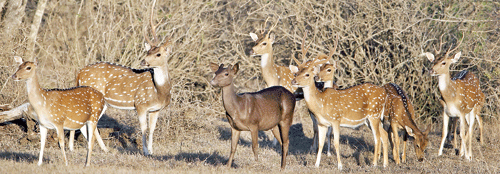
Rare sight:‘Kalu Muwa’ spotted in Wilpattu
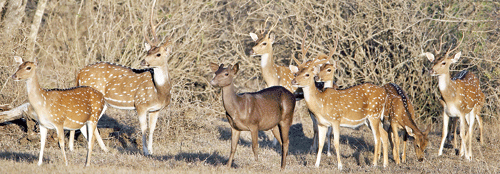 The ‘Black Spotted Deer’ amidst a herd of spotted deer. Pic by Kithsiri Gunawardena
The ‘Black Spotted Deer’ amidst a herd of spotted deer. Pic by Kithsiri GunawardenaIt was a single brief sighting of about 10 minutes at the Wilpattu National Park. But it was adequate for conservationist and photographer Kithsiri Gunawardena to be overjoyed.
For, what he saw was the ‘Black Spotted Deer’ or the ‘Kalu Muwa’ – a very rare melanistic Spotted Deer which he was able to photograph.
Here are Kithsiri’s notes:
“I received information from Mr. Seram who is an officer attached to the Department of Wildlife Conservation (DWC) of a black deer like animal that had been seen once or twice with a herd of Spotted Deer close to Pomparippu. No one was certain of the species of this strange animal as no one had seen such an animal in the wild. While some were of the opinion that it could be an immature sambhur, others wondered whether it is a hog deer. I had scheduled a field trip to Wilpattu from August 18-20 to engage in my study of leopards and other fauna and flora of the park and was quite keen to observe and photograph this strange animal.
“I spent three days at the park with Mr. D.M. Wasantha, a DWC guide, looking for this deer and was fortunate enough to have a single brief sighting one day of this uniquely coloured animal for about 10 minutes. Having examined the images, I was able to confirm that it is an extremely rare melanistic male Spotted Deer Axis axis.
“Melanism is the development of dark-coloured pigment, melanin, in the skin or its appendages and is the opposite of albinism, where the skin colour is white. While there have been a few records of albino mammals in the wild from Sri Lanka, melanistic animals such as the Black Leopard that was caught in an illegal snare in March 2009 from a village close to Deniyaya have been extremely rare.
“Spotted Deer are native to the Indian subcontinent. In Sri Lanka, they are found in the dry lowlands and are commonly seen in all the Dry Zone national parks. The upper parts of their skins are golden to rufous and are covered in white spots. The abdomen, rump, throat, insides of legs, ears and tail are all white. There are a few records of white coloured (albino) Spotted Deer in the past from our jungles, including the Wilpattu National Park where a water-hole is named as “sudu muwa wala” after an albino Spotted Deer that was seen in the early ’60s.
“Wilpattu is the largest and the oldest national park in the island with a unique cluster of breathtakingly beautiful water bodies which are referred to as Villus which support a multitude of species native to Sri Lanka. It is associated with the origins of the Sinhala race and holds so many places of archaeological importance. During my ongoing study, which began in 2011, I have so far recorded many species of fauna and flora including 208 species of birds, 31 species of mammals, 92 species of butterflies, 130 species of wild flowers and nine species of wild orchids from Wilpattu. My study of leopards has so far resulted in individually identifying and studying 76 different leopards. www.wilpattu.com
“This rare and unique specimen of the ‘Black Spotted Deer’ or ‘Kalu Muwa’ which has never been reported from any other park in the country is yet another reason for us to offer even greater protection to the Wilpattu National Park.”
Source – 27/08/2017, The Sunday times, See more at – http://www.sundaytimes.lk/170827/plus/rare-sightkalu-muwa-spotted-in-wilpattu-256101.html

Garbage crisis: Seoul searched and found a solution
Perched atop a hillock in Seoul, Korea, is the picturesque Sunset Park. It is resplendent in spring, with glorious bursts of flowers and foliage. Winter brings with it a peaceful serenity while families with children teem there in summer to camp on its grassy plains, play rounds of golf or catch butterflies. There is even an orchard, a vegetable plot and an herb garden.
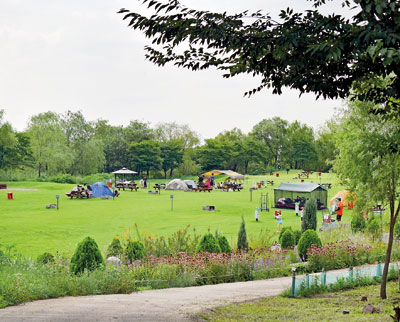
Camping at Sunset Park
It defies belief that this was once a landfill into which 92 million tonnes of garbage was dumped over a 15-year period. The slopes that sightseers stroll on are made entirely of rubbish. And here and there, methane pipes still rise from the ground while the area is constantly monitored as the garbage settles further with time.
Sunset Park–or ‘Neoul Park’ in Korean–is one of five that make up the World Cup Park in Sangamdong-gil, Seoul. They are arranged around the World Cup Stadium and were opened in May 2002, in time for the 17th FIFA World Cup hosted by Japan and Korea. This place was called Nanjido Island.
It wasn’t always so scenic. The landfill, which opened in 1978 and closed in 1993, stretched for 2.4 kilometres and was 98 metres tall. According to Korean urban planners, the absence of waste disposal sites led Nanjido to be turned into Seoul’s official dumpsite as it was easily accessible.
“Since this point, the once beautiful island with promising outlook slowly turned into land of death,” says Seoul Solution, a Seoul Metropolitan Government website. “From March 1978, trash began to be filled here, and in 1998, 28,877 tonnes of garbage was gushed [sic] out to the landfill site every day.” This went on till November 1992.
Serious environmental problems arose. Nanjido turned into a stinking mess that emitted harmful gases and effluents. The nearby Han River was badly affected while the air quality and ecosystem took a severe battering. So the Government devised a plan to transform the area into parks with views of Seoul.
This was a long-term, painstaking project that involved land stabilisation, topsoil levelling and soil recovery, leachate treatment, recycling of landfill gas and slope stabilisation. The project took many years to reach fruition and the results today are striking.
Some distance away is Incheon, a sprawling metropolis within which is located the world’s largest landfill site. The proposal here is to turn the massive dump, once it reaches maximum capacity, into a “Dream Park”. The whole operation is carried out by the Sudokwon Landfill Site Management Corporation (SLC) which, incidentally, helped Sri Lanka to build the Dompe sanitary landfill which was implemented with Korean International Cooperation Agency (KOICA) aid. That is just two hectares in extent. Sudokwon is 1,540 hectares.
When Nanjido was shut down, it was to this area that the Government shifted the waste of millions of inhabitants of Seoul. The local resistance to the plan is well-documented. Residents were fearful of air and water pollution, among other things. The authorities set up committees to allay their fears, opening the site up to inspections and monitoring by residents. After land-filling started, an operations committee was established along with a community support fund to improve the environment and quality of life in surrounding areas. Depositing of garbage kicked off in 1992. There was a learning process which led, today, to better methods of managing leachate, odour and other forms of pollution. The Government took a lead in most areas, even promulgating a law to set up the SLC as a public-private management body in 2000.
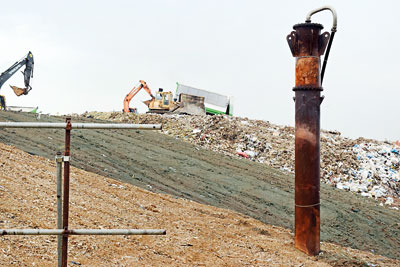
A layer of soil is applied every day over the garbage
Operations were centralised to avoid overlap and poor coordination among the metropolitan Governments of metropolitan area of Seoul, Incheon, and Gyeonggi-do. This way, waste management and civil complaints could be addressed in a harmonised manner. Without strong State backing, the project would not have been possible, authorities said.
Today, the adverse effects on the environment of the Sudkwon landfill are greatly reduced through sophisticated leachate and waste treatment techniques, says Hee Mun Lee, Deputy General Manager of SLC’s Climate Change Business Division. Mr Hee worked on the Dompe landfill site in Sri Lanka. Methane gas from buried garbage is used to generate energy which powers a turbine to generate electricity for the landfill site. This is now making profit.
Less lucrative is an ongoing initiative to turn garbage into combustible pellets which SLC then hopes to sell to private power generation firms. However, it is being continued as part of research and development. (Ten percent of all profits generated from operations at Sudokwon go towards the welfare of area residents).
At the same time as developing the Sudokwon site, the Government introduced a volume-based waste disposal fee which saw Koreans paying for the amount of waste they originated. Households and commercial entities have to buy designated bags to throw away their rubbish. Collection of recyclable waste is free. This caused a drop in the volume of garbage generated.
It was then decided to extend the lifetime of the Sudokwon site much beyond 2016, when it had been expected to reach capacity. This caused another spurt of protests from people who had expected the dumping to end on schedule. The dispute was recently resolved after it was agreed to hand ownership of the land to Incheon Metropolitan Government.
Today, rubbish is transported to the landfill site everyday in covered green trucks. Each time a layer of it is dumped, it is flattened by dozers and 0.2 metres of soil is laid on top of it. This happens every day and within five hours to prevent waste from dispersing, pests and foul odour from spreading and rainwater penetration.
The naturally-produced landfill gas (methane concentration of about 50%) is collected and transferred to a 50 megawatt power plant to simultaneously generate electricity and prevent foul odour. A cut-off wall on the bottom of landfill site prevents groundwater contamination and the leachate collected there goes to a treatment facility. Rainwater is removed through drains. Sterilizers and deodorizers are sprayed out while landfill waste treatment is underway. This includes smoke screen disinfection, road deodorization, upper-air deodorization and the sprinkling of water in surrounding areas.
The Sudokwon site has four sections. The first reached capacity and was closed in 2000. The second is receiving waste while the third is under preparation. The ultimate plan is to rehabilitate the whole area into Korea’s biggest eco-friendly park called ‘Dream Park’. The transformation is complete in the first section. Not only does it have a wildflower complex and a wetland observation zone, it boasts a soccer field, a basketball stadium and tennis courts and, of course, a public golf course.
(The writer’s visit was sponsored by the Korean Culture and Information Service to mark the 40th anniversary of diplomatic relations between Korea and Sri Lanka)
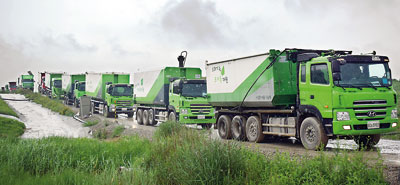
Covered garbage trucks arriving at the Sudokwon landfill site

Mr Hee, pointing to a model of the world’s largest landfill site
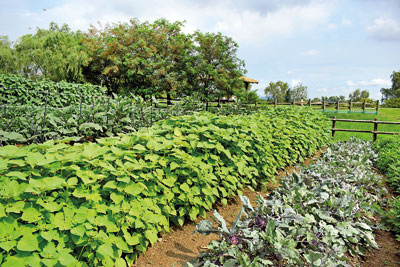
The vegetable and herb garden at Sunset Park
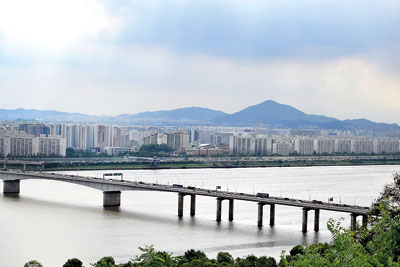
View of Seoul from Sunset Park
Source – 27/08/2017, The Sunday times, See more at – http://www.sundaytimes.lk/170827/news/garbage-crisis-seoul-searched-and-found-a-solution-256555.html



